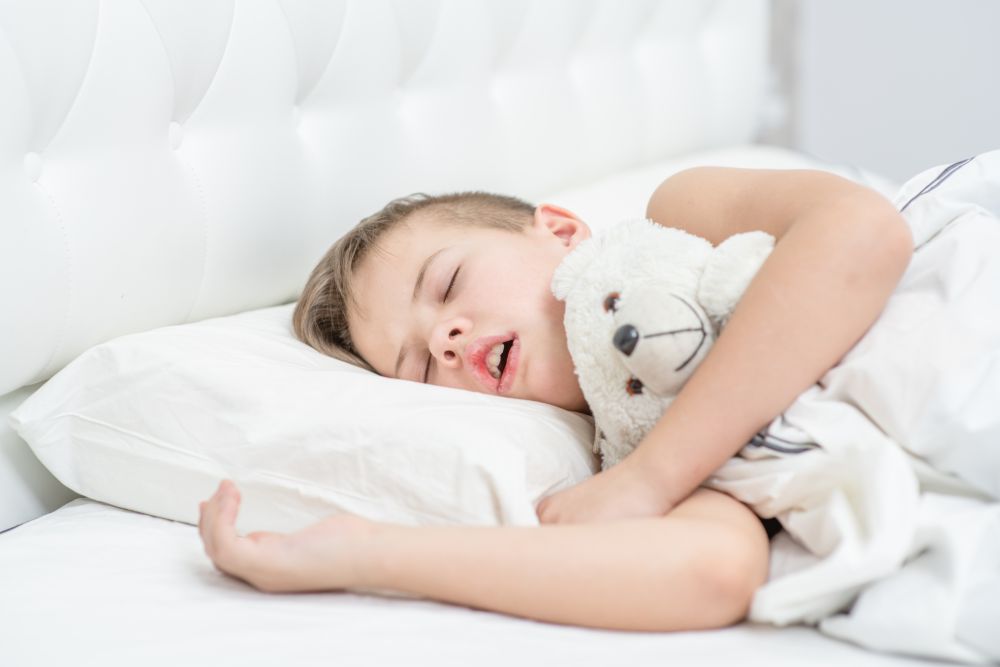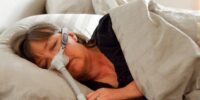Why Should You Address Sleep Apnea In Children And Adolescents?

Sleep apnea is a common yet often overlooked sleep disorder that affects children and adolescents. It is characterized by brief interruptions in breathing during sleep, leading to fragmented sleep patterns and inadequate oxygen supply to the body. This condition can have serious consequences on the health and well-being of young individuals if left untreated.
In this article, we will explore the reasons why it is crucial to address sleep apnea in children and adolescents. We will discuss the impact of untreated sleep apnea on academic performance, including impaired cognitive function and decreased attention span.
Additionally, we will delve into the behavioral problems that are associated with sleep apnea, such as hyperactivity and irritability.
Furthermore, we will explore the long-term health complications that can arise from untreated sleep apnea, including cardiovascular problems and metabolic disorders.
We will emphasize the importance of early intervention and diagnosis, as well as the available treatment options for sleep apnea in young individuals. Ultimately, the goal of this article is to shed light on the significance of addressing sleep apnea in children and adolescents and to promote their overall health and well-being.
Key Takeaways
- Sleep apnea in children and adolescents can have serious consequences on their health and well-being, including impairments in academic performance and behavioral problems.
- Untreated sleep apnea can lead to long-term health complications such as cardiovascular problems and metabolic disorders.
- Early intervention and diagnosis are crucial to address sleep apnea in young individuals and prevent these long-term complications.
- Treatment options for sleep apnea, such as continuous positive airway pressure (CPAP), oral appliances, and surgery, can significantly improve the quality of life for children and adolescents with sleep apnea.
The Definition and Causes of Sleep Apnea in Children and Adolescents
Sleep apnea in children and adolescents is a sleep disorder characterized by the partial or complete obstruction of the upper airway during sleep, leading to pauses in breathing and disrupted sleep patterns. This condition is typically caused by a variety of factors, including enlarged tonsils or adenoids, obesity, craniofacial abnormalities, and neuromuscular disorders.
The partial or complete blockage of the airway results in decreased oxygen levels in the blood and increased carbon dioxide levels, triggering the brain to briefly wake up and restore normal breathing. These repeated disruptions in sleep can lead to excessive daytime sleepiness, poor concentration, behavioral problems, and decreased academic performance.
Additionally, untreated sleep apnea in children and adolescents may result in long-term complications, such as cardiovascular issues, growth and development problems, and metabolic disorders. Thus, it is crucial to address and treat sleep apnea in this population to prevent potential negative impacts on their overall health and well-being.
The Impact of Untreated Sleep Apnea on Academic Performance
Untreated sleep apnea in young individuals has been shown to negatively impact their academic performance. Sleep apnea can lead to daytime sleepiness, difficulty concentrating, and decreased cognitive function, all of which can significantly hinder a child’s ability to succeed academically. Research has found that children with untreated sleep apnea are more likely to have lower grades, higher rates of absenteeism, and increased difficulty in completing assignments and tests. Moreover, they may exhibit behavioral problems and have a higher risk of developing attention deficit hyperactivity disorder (ADHD). It is crucial to address sleep apnea in children and adolescents to ensure optimal academic performance and overall well-being. Early diagnosis and appropriate treatment can alleviate the symptoms of sleep apnea and improve a child’s ability to focus, concentrate, and learn effectively.
| Impact of Untreated Sleep Apnea on Academic Performance | |||
|---|---|---|---|
| Lower grades | Higher rates of absenteeism | Difficulty completing assignments and tests | |
| Behavioral problems | Increased risk of developing ADHD | Impact of Untreated Sleep Apnea on Academic Performance | |
| :—: | :—: | :—: | |
| Lower grades | Higher rates of absenteeism | Difficulty completing assignments and tests | |
| Behavioral problems | Increased risk of developing ADHD | Impaired attention and memory |
Untreated sleep apnea can negatively affect a child’s academic performance by impairing their ability to focus, concentrate, and learn effectively. It can result in lower grades, increased rates of absenteeism, and difficulty completing assignments and tests. Additionally, it can contribute to behavioral problems and increase the risk of developing ADHD. The child may also experience impaired attention and memory, further hindering their learning capabilities.
Behavioral Problems Associated with Sleep Apnea in Young Individuals
Behavioral problems, such as impulsivity and irritability, have been observed in young individuals with sleep apnea. These issues can significantly impact a child’s daily functioning and overall quality of life.
Some of the specific behavioral problems associated with sleep apnea in young individuals include:
- Hyperactivity: Children with sleep apnea may display excessive levels of activity and restlessness.
- Poor attention span: Sleep apnea can lead to difficulties in maintaining attention and concentration.
- Aggression: Children with sleep apnea may exhibit increased levels of aggression and irritability.
- Mood swings: Sleep apnea can contribute to frequent and intense shifts in a child’s mood.
- Poor impulse control: Young individuals with sleep apnea may struggle with regulating their impulses and making impulsive decisions.
Addressing sleep apnea in children and adolescents is crucial to improve their behavioral functioning and enhance their overall well-being. By treating sleep apnea, these behavioral problems can be effectively managed, allowing young individuals to thrive academically, socially, and emotionally.
Long-Term Health Complications of Untreated Sleep Apnea
One critical aspect to consider when examining the impact of sleep apnea in young individuals is the potential long-term health complications that can arise from this condition.
Untreated sleep apnea in children and adolescents has been linked to a range of serious health issues. One of the most significant long-term complications is cardiovascular disease, including high blood pressure, heart disease, and stroke.
Sleep apnea can also lead to metabolic disorders such as obesity and insulin resistance, increasing the risk of developing type 2 diabetes.
Additionally, untreated sleep apnea can negatively affect cognitive function, leading to learning difficulties, poor academic performance, and behavioral problems.
Furthermore, sleep apnea has been associated with an increased risk of developing mood disorders such as depression and anxiety.
Addressing sleep apnea in children and adolescents is essential to prevent these potential long-term health complications and improve overall well-being.
Importance of Early Intervention and Diagnosis
Early intervention and diagnosis play a crucial role in mitigating the potential long-term health complications associated with sleep apnea in young individuals, ensuring a healthier and brighter future.
Early identification of sleep apnea in children and adolescents can lead to timely intervention and treatment, which can significantly improve their quality of life. Untreated sleep apnea can have detrimental effects on various aspects of a young individual’s health, including cardiovascular, cognitive, and behavioral functioning.
By diagnosing sleep apnea at an early stage, healthcare providers can implement appropriate interventions such as continuous positive airway pressure (CPAP) therapy or other treatment modalities. These interventions can help prevent further health deterioration and promote healthy sleep patterns, reducing the risk of developing long-term complications.
Additionally, early intervention can also address any underlying causes or contributing factors to sleep apnea, such as obesity or anatomical abnormalities, further enhancing the effectiveness of treatment.
Overall, early intervention and diagnosis are essential in managing sleep apnea in children and adolescents, ensuring optimal health outcomes in the long run.
Treatment Options for Sleep Apnea in Children and Adolescents
Treatment options for sleep apnea in pediatric and adolescent populations encompass a range of therapeutic modalities aimed at improving respiratory function and promoting healthy sleep patterns. These treatment options include:
- Continuous Positive Airway Pressure (CPAP): This is the most common and effective treatment for sleep apnea in children and adolescents. CPAP involves wearing a mask during sleep that delivers a continuous flow of air to keep the airway open.
- Oral appliances: These devices are custom-made and fit over the teeth to help keep the airway open by repositioning the jaw and tongue.
- Surgery: In some cases, surgery may be recommended to remove excess tissue or correct structural abnormalities that are causing the sleep apnea.
It is important for healthcare providers to carefully assess each individual case to determine the most appropriate treatment option based on the severity of the sleep apnea and the individual’s specific needs. By addressing sleep apnea in children and adolescents, healthcare providers can help improve their overall health and quality of life.
Improving Quality of Life through Sleep Apnea Treatment
Sleep apnea in children and adolescents can significantly impact their quality of life, leading to various physical and psychological consequences. Treatment options for sleep apnea in this population aim to improve their overall well-being by addressing the underlying causes and symptoms of the condition.
By implementing appropriate treatment strategies, such as continuous positive airway pressure (CPAP), surgery, or oral appliances, the quality of life for children and adolescents with sleep apnea can be improved. These treatments can help alleviate daytime sleepiness, enhance cognitive function, and promote healthy growth and development.
Additionally, addressing sleep apnea in this age group can reduce the risk of long-term complications, such as cardiovascular diseases and behavioral problems. Thus, it is essential to consider and implement appropriate treatment options to improve the quality of life for children and adolescents with sleep apnea.
Promoting Overall Health and Well-being in Young Individuals through Sleep Apnea Management
By prioritizing the comprehensive management of sleep apnea in young individuals, their overall health and well-being can be significantly enhanced. Sleep apnea in children and adolescents has been associated with a range of adverse health outcomes, including cardiovascular problems, metabolic disorders, cognitive impairments, and behavioral issues. Effective management of sleep apnea can alleviate these concerns and promote better health in young individuals.
One of the key benefits of addressing sleep apnea in children and adolescents is the improvement in cardiovascular health. Sleep apnea has been linked to an increased risk of hypertension, atherosclerosis, and other cardiovascular diseases. By managing sleep apnea, the risk of these conditions can be reduced, leading to better cardiovascular health in young individuals.
Furthermore, sleep apnea treatment can also help in managing metabolic disorders. Sleep-disordered breathing has been found to be associated with insulin resistance, obesity, and dyslipidemia in children and adolescents. By addressing sleep apnea, these metabolic abnormalities can be controlled or even reversed, leading to improved metabolic health.
Cognitive impairments are another concern associated with sleep apnea in young individuals. Sleep disturbances can negatively impact cognitive function, including attention, memory, and executive functions. By managing sleep apnea, cognitive impairments can be mitigated, leading to better academic performance and overall cognitive development.
Behavioral issues are also commonly observed in children and adolescents with sleep apnea. Sleep disturbances can lead to irritability, mood swings, hyperactivity, and poor impulse control. By addressing sleep apnea, these behavioral problems can be effectively managed, leading to improved behavior and overall well-being in young individuals.
Prioritizing the comprehensive management of sleep apnea in young individuals is crucial for promoting their overall health and well-being. By addressing sleep apnea, cardiovascular health, metabolic disorders, cognitive impairments, and behavioral issues can be effectively managed, leading to better health outcomes and an improved quality of life for children and adolescents.
| Benefits of Addressing Sleep Apnea in Young Individuals | |
|---|---|
| Cardiovascular Health | – Reduced risk of hypertension, atherosclerosis, and cardiovascular diseases |
| Metabolic Health | – Control or reversal of insulin resistance, obesity, and dyslipidemia |
| Cognitive Function | – Mitigation of cognitive impairments, improved academic performance |
| Behavioral Issues | – Management of irritability, mood swings, and hyperactivity, leading to improved behavior |
Frequently Asked Questions
How common is sleep apnea in children and adolescents?
Sleep apnea is a common condition in children and adolescents, with prevalence rates ranging from 1% to 4%. It is important to address sleep apnea in this population due to its potential negative impacts on physical and cognitive development.
What are the symptoms of sleep apnea in young individuals?
The symptoms of sleep apnea in young individuals include loud snoring, pauses in breathing during sleep, restless sleep, daytime sleepiness, difficulty concentrating, irritability, and behavioral problems.
Can sleep apnea in children and adolescents resolve on its own without treatment?
Sleep apnea in children and adolescents may not resolve on its own without treatment. Untreated sleep apnea can lead to various health problems, including daytime sleepiness, behavioral issues, cognitive impairments, and cardiovascular complications.
Are there any specific risk factors for developing sleep apnea at a young age?
Risk factors for developing sleep apnea at a young age include obesity, enlarged tonsils or adenoids, craniofacial abnormalities, genetic predisposition, and certain medical conditions. Early identification and treatment of sleep apnea is crucial to prevent long-term complications and improve overall health outcomes.
How does sleep apnea affect the physical growth and development of children and adolescents?
Sleep apnea in children and adolescents can negatively impact physical growth and development. It can lead to stunted growth, cognitive impairments, cardiovascular problems, and behavioral issues, highlighting the importance of addressing this condition in this population.










